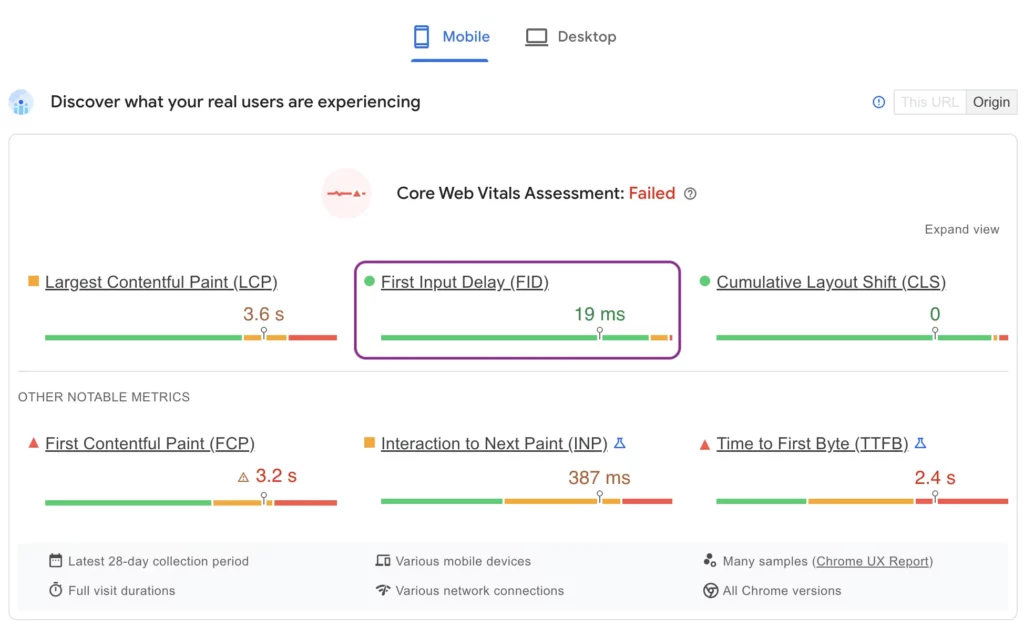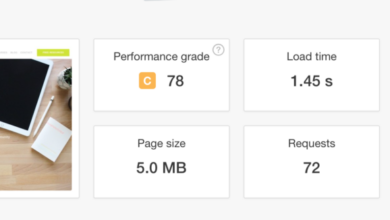
First Input Delay A Web Performance Deep Dive
First input delay (FID) is a crucial metric for evaluating how quickly a website responds to user interaction. It measures the time it takes for a page to become interactive, essentially from the moment a user clicks or taps on something to when the browser actually responds. Understanding and optimizing FID is paramount for a positive user experience, influencing everything from perceived website speed to user engagement and conversion rates.
This comprehensive guide delves into the intricacies of FID, exploring its definition, measurement, optimization strategies, and its profound impact on user experience. We’ll analyze the key factors influencing FID, from server response time to client-side rendering, and provide practical steps for identifying and resolving bottlenecks. We’ll also look at case studies to illustrate the real-world implications of FID optimization.
First Input Delay (FID) Definition and Scope
First Input Delay (FID) is a crucial metric in web performance, specifically focusing on how quickly a user’s interaction with a website is processed and responded to. It measures the time elapsed between a user’s first interaction (like clicking a button or typing) and the browser’s ability to begin processing that interaction. Understanding FID helps developers optimize user experience and improve website usability.FID’s significance stems from its direct correlation with user perception of responsiveness.
A low FID indicates a fast and responsive website, while a high FID suggests a sluggish and potentially frustrating experience. This metric is especially important in today’s fast-paced digital environment where users expect immediate feedback from websites.
Definition of First Input Delay
First Input Delay (FID) is the time elapsed between a user’s first input event and the browser’s ability to begin processing that input. It’s not the time it takes to render the entire page, but rather the time it takes to initiate the processing of the user’s interaction. This processing includes things like JavaScript execution and rendering updates, and the crucial part is that it must begin.
A short FID indicates a quick response to user actions.
First input delay, that frustrating moment when you click a button and nothing happens for a split second, is crucial for user experience, especially on international Facebook global pages. Optimizing this delay is key to keeping users engaged and satisfied, and it’s something to consider when managing large-scale international campaigns. For a deeper dive into Facebook’s global presence and potential implications for first input delay, check out this great resource on international Facebook global pages.
Ultimately, understanding and minimizing first input delay is paramount for a positive user experience, no matter the platform or audience.
Significance of FID in Web Performance
FID is significant in web performance because it directly measures how quickly a user’s interaction is processed. A low FID signifies a more responsive website, which is essential for a positive user experience. Users perceive a fast-loading website with a low FID as more intuitive and efficient. Conversely, a high FID can lead to frustration and potentially drive users away.
This metric is critical for maintaining user engagement and satisfaction.
Metrics Used to Measure FID
Several metrics are used to measure FID, all aimed at capturing the time it takes for the browser to start processing user input. The most common and widely adopted metric is the average FID across multiple user interactions. This average provides a reliable representation of the overall responsiveness of the website. Other metrics might include percentiles (e.g., 75th percentile FID), which offer insights into the responsiveness for different user segments.
Contexts Where FID is Crucial
FID’s importance varies depending on the context. For mobile web experiences, where users often have limited bandwidth and processing power, FID is particularly crucial. A slow FID can significantly impact the user experience on mobile devices, leading to frustration and potentially higher bounce rates. On desktop, FID is still important, though the impact might be slightly less pronounced.
Comparison of FID with Other Performance Metrics
| Metric | Focus | Key Differences |
|---|---|---|
| First Input Delay (FID) | Time to begin processing user input | Focuses on the responsiveness of the page to user actions, rather than the complete page load time. |
| Largest Contentful Paint (LCP) | Time to render the largest content element | Measures the time to render the most significant visual element on the page, providing a different perspective on the page load process. |
| Cumulative Layout Shift (CLS) | Visual stability of the page | Focuses on how much the page content shifts unexpectedly after initial rendering, highlighting the visual stability of the experience. |
FID, LCP, and CLS are distinct performance metrics, each providing a unique perspective on the user experience. FID is about the responsiveness of the website to user actions; LCP measures the visual completion of the most significant content; and CLS quantifies the visual stability of the page. Understanding the differences between these metrics is crucial for a comprehensive analysis of web performance.
Factors Influencing FID: First Input Delay
First Input Delay (FID) is a critical metric for assessing the responsiveness of a web application. Understanding the factors that contribute to FID is crucial for optimizing user experience and improving website performance. A low FID translates to a more snappy and engaging user experience, whereas a high FID can lead to frustration and abandonment.Several key factors influence FID, impacting how quickly a user can interact with a webpage.
First input delay, that frustrating moment when a website feels sluggish, is crucial to consider in your SEO strategy. A slow site hurts user experience, impacting everything from bounce rates to conversions. Optimizing for speed, including a robust seo pillar page content strategy that focuses on high-quality, comprehensive content, is key to reducing first input delay.
Ultimately, a smooth user experience, achieved through site speed improvements, directly benefits your search engine rankings and overall online presence.
These factors range from server infrastructure to client-side processing, highlighting the interconnected nature of front-end and back-end optimization. Analyzing each component allows for a more holistic approach to minimizing FID and improving overall performance.
Server Response Time
Server response time plays a significant role in FID. The time it takes for the server to process a user’s request and send the initial HTML response directly impacts the perceived responsiveness of the website. Faster server response times translate to quicker FID values, ensuring a smoother user experience. For example, a web application with a slow database query or a poorly optimized server configuration will likely have a higher FID than one with optimized server resources and quick database queries.
Client-Side Rendering, First input delay
Client-side rendering (CSR) involves dynamically updating the user interface on the client-side browser. This can significantly impact FID. Heavy or inefficient CSR processes can lead to delays, increasing FID. Conversely, efficient rendering techniques can minimize the time required for the initial page load, resulting in a lower FID. A well-structured CSR architecture with optimized rendering strategies is essential to minimize FID.
JavaScript Execution
JavaScript execution is another major factor influencing FID. Large amounts of JavaScript code or poorly optimized scripts can lead to significant delays in the initial rendering phase. Furthermore, asynchronous operations, if not handled carefully, can also cause delays. Implementing asynchronous operations effectively can minimize FID and enhance responsiveness. Employing efficient JavaScript libraries and optimized coding practices can help reduce the impact of JavaScript on FID.
Impact of Front-End Frameworks on FID
Different front-end frameworks can have varying impacts on FID. The efficiency of the framework’s rendering engine and its handling of JavaScript tasks directly affects the loading time.
| Framework | FID Impact | Explanation |
|---|---|---|
| React | Generally Low | React’s virtual DOM and efficient reconciliation algorithm typically contribute to lower FID values. |
| Angular | Can Vary | Angular’s architecture can sometimes lead to longer initial load times depending on the complexity of the application. |
| Vue.js | Generally Low | Vue.js’s lightweight nature and efficient templating engine contribute to a generally low FID. |
| Svelte | Generally Low | Svelte’s compile-time approach translates to very fast initial rendering and lower FID. |
Correlation Between FID and User Experience
The correlation between FID and user experience is strong. A low FID leads to a better user experience, characterized by faster loading times, smoother interactions, and increased user satisfaction. Conversely, a high FID can result in frustration, reduced engagement, and a negative user experience. The relationship between FID and user experience is crucial in web application development.
| FID | User Experience | Impact |
|---|---|---|
| Low (e.g., <50ms) | Excellent | Fast, responsive, and enjoyable user experience. |
| Medium (e.g., 50ms – 150ms) | Good | Satisfactory but potential for noticeable delays. |
| High (e.g., >150ms) | Poor | Slow, unresponsive, and frustrating user experience. |
Measuring and Monitoring FID

First Input Delay (FID) is a crucial metric for assessing the responsiveness of a web application. Understanding how to measure and monitor FID is essential for optimizing user experience and ensuring a smooth, interactive website. A low FID score indicates a faster initial response, leading to a more engaging user experience. Conversely, a high FID score points to sluggish initial interactions, potentially causing user frustration and abandonment.Accurate FID measurement is paramount for identifying performance bottlenecks and implementing targeted improvements.
Monitoring FID over time allows for tracking progress, evaluating the effectiveness of optimization efforts, and ensuring the application remains responsive as user needs evolve.
Measuring FID Using Browser Tools
Modern web browsers offer built-in tools to measure FID. These tools provide detailed performance metrics, including FID, which allows developers to identify areas for optimization. Tools like Chrome DevTools and Firefox Developer Tools provide comprehensive performance profiling capabilities. These tools capture performance data during user interactions, providing valuable insights into the factors contributing to FID.
Integrating FID Monitoring into Web Development Workflows
Integrating FID monitoring into web development workflows ensures continuous performance improvement. This involves incorporating performance testing into the development cycle, from initial design to final deployment. By automating performance checks, developers can catch performance issues early, reducing the time and resources needed to fix them later. Using automated testing tools to measure FID during development phases allows for continuous feedback loops, leading to proactive performance optimization.
First input delay, that frustrating moment when you click and nothing happens, can seriously impact user experience. It’s a crucial factor in website design, and surprisingly, it’s related to the effectiveness of advertising campaigns like Facebook ads. Ultimately, if your ad is taking forever to load or react, it’s likely to drive users away. Knowing if your Facebook ad strategy is paying off requires considering the overall user experience, and understanding factors like first input delay.
To delve deeper into the profitability of Facebook ads, check out this great resource: are facebook ads worth it. In the end, optimizing for fast first input delay is key to engaging users and ultimately, getting the most out of your digital marketing.
Continuous FID Tracking and Reporting
Implementing a system for continuous FID tracking and reporting is crucial for maintaining optimal performance. This system should automatically collect FID data from various user segments and environments. The collected data can be visualized through dashboards and reports, providing clear insights into performance trends. This allows for proactive identification of potential performance problems before they impact users.
Identifying Bottlenecks Impacting FID
Identifying bottlenecks impacting FID requires a methodical approach. Developers should analyze performance data to pinpoint the areas causing delays in the initial response to user interactions. Techniques like network profiling and JavaScript execution analysis can help isolate performance issues. Tools designed to analyze network requests and JavaScript code can pinpoint specific code segments or network requests that contribute to high FID.
Tools for Measuring and Analyzing FID
Various tools are available to measure and analyze FID. These tools automate the process of collecting and analyzing performance data. Their use simplifies the process of identifying and addressing performance bottlenecks.
| Tool | Description | Pros | Cons |
|---|---|---|---|
| Chrome DevTools | Built-in browser tool | Free, comprehensive, easy to use | Limited customizability, may not be suitable for large-scale monitoring |
| WebPageTest | Cloud-based performance testing tool | Detailed reports, various testing environments | Paid, may not be integrated with existing workflows |
| Lighthouse | Automated audit tool | Integrates with CI/CD, simple to use | Limited in-depth analysis compared to dedicated tools |
Using Performance Logging for Detailed FID Analysis
Performance logging provides a detailed breakdown of events contributing to FID. This allows developers to analyze the exact sequence of events leading to delays. Performance logs can pinpoint issues in the front-end rendering process, network requests, or JavaScript execution. Thorough performance logging facilitates detailed analysis, enabling developers to identify the specific cause of FID issues.
Optimizing for Lower FID
First Input Delay (FID) is a crucial metric for evaluating the responsiveness of a web application. A lower FID indicates a faster initial response to user interaction, leading to a more enjoyable and efficient user experience. Optimizing for lower FID requires a multifaceted approach that tackles both server-side and client-side performance bottlenecks. This section delves into strategies for minimizing FID across various stages of the application lifecycle.
Optimizing Server-Side Rendering
Server-side rendering (SSR) can significantly impact FID by pre-rendering the initial HTML of a page on the server. This eliminates the need for extensive client-side JavaScript execution before the user can interact with the page. Optimizing SSR involves reducing the time taken to generate the initial HTML. This includes improving server-side code efficiency, optimizing database queries, and ensuring efficient caching mechanisms.
- Efficient Server-Side Code: Employing optimized algorithms and data structures can significantly improve the speed at which the server renders the page. For instance, using a compiled language like Node.js with optimized libraries can often yield faster execution than interpreted languages.
- Optimized Database Queries: Carefully constructed database queries that target specific data and avoid unnecessary joins can substantially decrease the time taken to fetch information for rendering.
- Caching Strategies: Implementing robust caching mechanisms at the server-level can dramatically reduce the time taken to generate static resources. This includes caching frequently accessed data and pre-rendered components.
Optimizing Client-Side JavaScript
Minimizing client-side JavaScript execution time is critical for reducing FID. Techniques like code splitting, lazy loading, and efficient JavaScript libraries can improve the initial load time of a page and its responsiveness.
- Code Splitting: Breaking down large JavaScript bundles into smaller, more manageable chunks allows the browser to load only the necessary code for the initial rendering phase. This reduces the initial payload and the time taken to execute the JavaScript code.
- Lazy Loading: Loading resources only when they are needed improves the perceived responsiveness. This is particularly beneficial for non-critical components or assets that can be loaded later without significantly impacting the initial user experience.
- Efficient JavaScript Libraries: Choosing optimized JavaScript libraries and frameworks can significantly reduce the time taken for client-side processing. For instance, libraries with efficient rendering and animation mechanisms can improve performance.
Effective Caching Strategies
Caching is crucial for improving FID. Caching strategies involve storing frequently accessed resources (e.g., images, CSS files, JavaScript files) to reduce the time needed to retrieve them from the server. A well-implemented caching strategy reduces the latency between user interaction and the server’s response.
- Browser Caching: Leveraging browser caching ensures that frequently accessed resources are stored in the user’s browser, eliminating the need to fetch them from the server on subsequent visits.
- Server-Side Caching: Caching frequently requested data and resources on the server can improve performance for multiple users.
- Content Delivery Networks (CDNs): Using CDNs can distribute cached resources across multiple servers, reducing latency and improving response times for users worldwide.
Minimizing Third-Party Script Impact
Third-party scripts can significantly impact FID due to their potential for asynchronous loading and potentially large download sizes. Minimizing the number of third-party scripts and optimizing their loading is critical.
- Script Optimization: Employing optimized and lean third-party libraries reduces the impact on FID.
- Asynchronous Loading: Loading third-party scripts asynchronously can minimize the blocking of the initial page load.
- Lazy Loading of Third-Party Scripts: Only load essential third-party scripts when they are required, minimizing initial load time.
Code Splitting and Lazy Loading
Code splitting and lazy loading techniques reduce the initial payload of JavaScript code by loading it in smaller chunks or on demand. This results in a faster initial response to user interactions.
- Progressive Enhancement: Using code splitting and lazy loading allows developers to implement complex features without impacting the initial load time and user experience.
- Modular Design: Designing applications with modular components facilitates code splitting, making the loading process more efficient and reducing initial load times.
FID Optimization Strategies: Pros and Cons
| Strategy | Pros | Cons |
|---|---|---|
| Server-Side Rendering | Faster initial load, improved FID, benefits | Increased server load, potential complexity |
| Client-Side Optimization | Reduced client-side load, easier maintenance | Potential impact on , requires client-side code changes |
| Caching | Reduced latency, improved performance | Potential for stale data, requires careful configuration |
| Third-Party Script Optimization | Improved performance, reduced FID | Requires careful management of dependencies |
| Code Splitting/Lazy Loading | Faster initial load, reduced bundle size | Requires more complex code, potentially more complex maintenance |
FID and User Experience
First Input Delay (FID) is more than just a technical metric; it directly impacts the user experience. A fast FID translates to a seamless, responsive website, while a high FID results in a frustrating, sluggish experience. Understanding this connection is crucial for website owners and developers. This section delves into the profound relationship between FID and user experience, exploring its effects on engagement, satisfaction, and ultimately, business outcomes.
Relationship Between FID and Perceived Website Speed
Users perceive website speed not just by the time it takes to fully load, but also by how quickly the initial interaction responds. A low FID means the page responds instantly to user input, creating the impression of a fast, responsive site. Conversely, a high FID creates a noticeable delay, making the website feel slow and unresponsive. Users often associate this delay with a slower overall loading time, even if the actual load time is not impacted significantly.
Impact of FID on User Engagement and Conversion Rates
FID directly influences user engagement. A low FID fosters a positive interaction, encouraging users to explore further and stay longer on the site. Conversely, high FID can deter users from interacting further. The immediate response to user input is paramount. Studies have shown a strong correlation between lower FID and higher conversion rates.
Users are more likely to complete desired actions (e.g., making a purchase, signing up) on a site that feels responsive and immediate.
Correlation Between FID and User Satisfaction
User satisfaction is significantly influenced by FID. A smooth and immediate response to user input leads to higher user satisfaction. Conversely, a noticeable delay can lead to frustration and dissatisfaction, impacting the overall user experience. Users are less likely to return to or recommend a website with a poor FID.
Impact of FID on Different User Demographics
The impact of FID varies slightly across different user demographics. While generally true, the following table Artikels a possible trend:
| User Demographic | Potential Impact of High FID |
|---|---|
| Mobile users | More likely to abandon the site due to the slow response time on smaller screens. |
| Users with slower internet connections | Experience more significant delays and frustration, impacting satisfaction and engagement. |
| Users performing critical tasks | May face interruptions and frustration when performing tasks that require rapid responses (e.g., online banking, financial transactions). |
| Users with high expectations | May find the delay unacceptable and switch to competitor sites, impacting conversion rates. |
This table highlights the importance of considering diverse user needs when optimizing FID. The user experience must cater to varying needs and expectations.
Examples of Websites with Low FID Performing Better
Numerous websites demonstrate the positive impact of low FID. For example, e-commerce sites with quick product loading and navigation often have significantly lower bounce rates and higher conversion rates. Similarly, websites that require quick user interactions (e.g., online games, interactive educational platforms) benefit greatly from low FID. These sites consistently see higher engagement rates, positive feedback, and ultimately, greater success.
Influence of FID on Bounce Rates
High FID significantly increases bounce rates. A slow response to user input discourages continued interaction, leading users to abandon the site quickly. This directly translates to a higher bounce rate. In contrast, websites with low FID often see lower bounce rates as users are more likely to explore the site and engage with its content. A quick response to user input is crucial for retaining users.
Case Studies and Examples

Understanding how websites with varying FID perform in the real world is crucial for appreciating the impact of optimization. This section delves into specific case studies, highlighting websites with both high and low FID, examining their optimization strategies, and demonstrating the resulting user experience improvements. Analyzing successful strategies across different website types provides valuable insights for developers seeking to enhance their own applications.
Real-World Examples of High and Low FID
Websites exhibit a wide spectrum of FID values. High FID often leads to frustrating user experiences, while low FID results in a seamless and responsive user interface. Consider a news website displaying a lengthy loading time before content appears, contrasted with a social media platform that quickly loads posts. The former exemplifies a high FID, whereas the latter showcases a low FID.
Optimization Strategies for Lower FID
Numerous strategies exist for optimizing FID. One effective approach is optimizing images by compressing them without sacrificing quality. Using optimized images significantly reduces the time required for loading, which, in turn, decreases FID. Caching static assets is another powerful optimization technique. By storing frequently accessed files locally, the server’s workload is reduced, and loading times are improved.
Impact of FID Improvements on User Experience
Improving FID yields substantial improvements in user experience. Users perceive faster load times as more responsive and intuitive, leading to higher satisfaction and engagement. A website with a low FID will generally receive more positive feedback and encourage users to remain engaged.
Success Stories of Websites with Low FID
- Many e-commerce websites, such as Amazon, have consistently prioritized low FID. By utilizing various optimization techniques, including image optimization, caching, and efficient server infrastructure, they provide a seamless and quick shopping experience, which directly translates to higher sales and customer satisfaction.
- Streaming services like Netflix are another prime example. They meticulously optimize their platforms to ensure fast loading times and a smooth user experience. Their focus on efficient video streaming protocols, combined with effective caching strategies, results in low FID and high user satisfaction.
Successful FID Optimization Strategies for Different Website Types
The ideal FID optimization strategy varies based on the website’s nature.
- E-commerce websites benefit from optimized images and responsive design, which is critical for smooth scrolling and fast loading. Utilizing a Content Delivery Network (CDN) is also crucial to ensure content is served from servers closest to users, minimizing latency.
- News websites benefit from optimized images, minimized HTTP requests, and a well-structured front-end architecture. By focusing on these aspects, news websites can maintain fast loading times, ensuring users can quickly access information.
- Social media platforms often rely on effective caching strategies, efficient database queries, and the implementation of robust APIs to deliver a seamless user experience, enabling users to load content quickly and easily.
Closing Summary
In conclusion, optimizing for low first input delay is essential for creating a seamless and engaging web experience. By understanding the factors influencing FID and implementing the optimization strategies discussed, developers can significantly improve user satisfaction and ultimately drive better business outcomes. A faster, more responsive website leads to happier users, and ultimately, a better bottom line.




